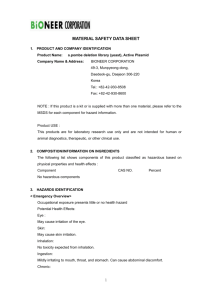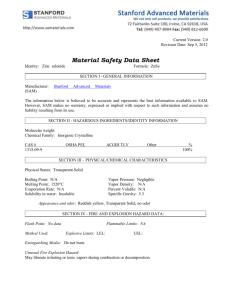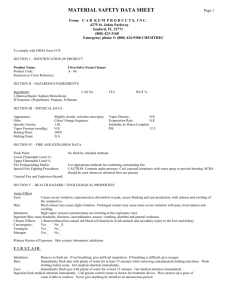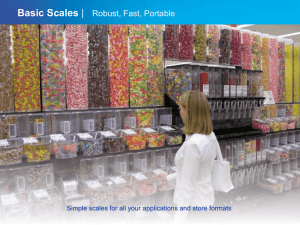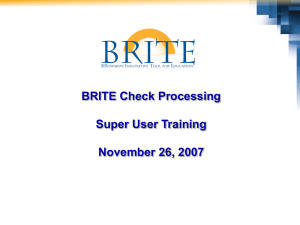Brass Brite MSD Sheet
advertisement
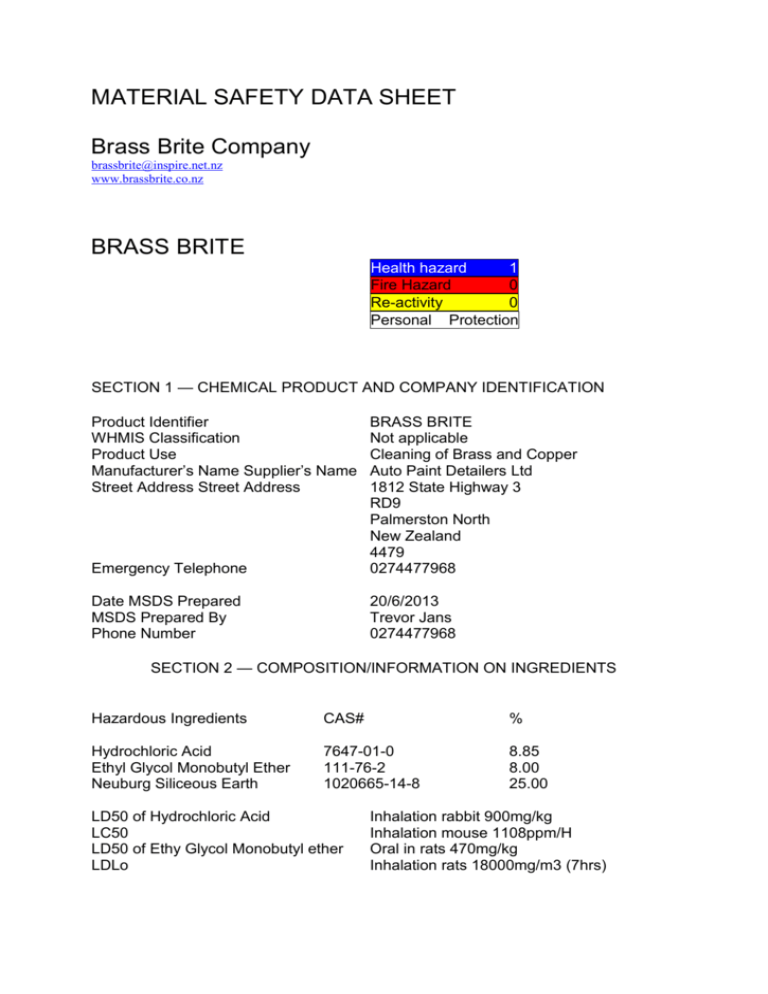
MATERIAL SAFETY DATA SHEET Brass Brite Company brassbrite@inspire.net.nz www.brassbrite.co.nz BRASS BRITE Health hazard 1 Fire Hazard 0 Re-activity 0 Personal Protection SECTION 1 — CHEMICAL PRODUCT AND COMPANY IDENTIFICATION Product Identifier WHMIS Classification Product Use Manufacturer’s Name Supplier’s Name Street Address Street Address Emergency Telephone BRASS BRITE Not applicable Cleaning of Brass and Copper Auto Paint Detailers Ltd 1812 State Highway 3 RD9 Palmerston North New Zealand 4479 0274477968 Date MSDS Prepared MSDS Prepared By Phone Number 20/6/2013 Trevor Jans 0274477968 SECTION 2 — COMPOSITION/INFORMATION ON INGREDIENTS Hazardous Ingredients CAS# % Hydrochloric Acid Ethyl Glycol Monobutyl Ether Neuburg Siliceous Earth 7647-01-0 111-76-2 1020665-14-8 8.85 8.00 25.00 LD50 of Hydrochloric Acid LC50 LD50 of Ethy Glycol Monobutyl ether LDLo Inhalation rabbit 900mg/kg Inhalation mouse 1108ppm/H Oral in rats 470mg/kg Inhalation rats 18000mg/m3 (7hrs) Neuburg Siliceous Earth when airborne is known to causes damage to lungs through prolonged or repeated inhalation, but is in suspension in Brass Brite and not liberated even after dehydration of the product SECTION 3 — HAZARDS IDENTIFICATION Route of Entry Skin contact, Eye contact, Ingestion, Inhalation WHMIS symbol N/A Potential health effects eye irritation from siliceous earth SECTION 4 — FIRST AID MEASURES Skin Contact Flush with fresh water, household soap can be used to aid neutralisation of acidic property. Flush with fresh water. Provide moving fresh air. Drink fresh water or milk do NOT induce vomiting. Eye Contact Inhalation Ingestion SECTION 5 — FIRE FIGHTING MEASURES Not known to be flammable, fire-fighting measures may include water spray CO2 or dry powder options Flashpoint (C) Explosion Data Sensitivity to Static Discharge Hazardous Combustion Products NFPA N/A Not known to be explosive under any conditions Nil None known N/A SECTION 6 — ACCIDENTAL RELEASE MEASURES Leak and Spill Procedures Potentially hazardous to marine life, dilute with water and block from waterways. Apply absorbent material to mop up spill. Use rubber or other barrier providing gloves and ensure free flowing fresh air or vapour mask. SECTION 7 — HANDLING AND STORAGE Handling Procedures and Equipment Storage Requirements If containers are damaged use rubber gloves for product handling and ventilate the area No special requirements SECTION 8 — EXPOSURE CONTROL / PERSONAL PROTECTION Exposure Limits No known limits Specific Engineering Controls use in ventilated area, for prolonged use ensure moving fresh area to avoid vapour build up/exposure. Personal Protective Equipment rubber gloves and eye guards such as safety glasses. SECTION 9 — PHYSICAL AND CHEMICAL PROPERTIES Physical State Odour Appearance Specific Gravity Boiling Point (C) pH Coefficient of Water/Oil Distribution Sweet, not unpleasant Creamy white liquid 1.04 120 – 130 Acidic Soluble in Water SECTION 10 — STABILITY AND REACTIVITY Chemical Stability Incompatibility with Other Substances Reactivity Hazardous Decomposition Products Chemically stable may react to strong oxidising agents may react to strong oxidising agents None known SECTION 11 — TOXICOLOGICAL INFORMATION Effects of Acute Exposure Effects of Chronic Exposure Irritancy of Product Skin Sensitisation Carcinogenicity Reproductive Toxicity Teratogenicity Embryotoxicity Mutagenicity Noticeable tissue irritation in the event of eye contact on going tissue exposure will worsen irritation causing noticeable reddening. Nausea and dizziness may be experienced with chronic exposure to fumes. Irritant to eye tissues Not known to be cumulatively irritant. None known None known None known SECTION 12 — ECOLOGICAL INFORMATION Aquatic Toxicity disperses in water, likely to be hazardous to marine life in concentration. SECTION 13 — DISPOSAL CONSIDERATIONS Waste Disposal Dispose of as per statutory regulations for ingredients SECTION 14 — TRANSPORT INFORMATION Special Shipping Information unclassified under DOT classifications SECTION 15 — REGULATORY INFORMATION [WHMIS Classification] Not classified [OSHA] SIC code 2842 [TSCA] N/A HMIS Health hazard 1 Fire Hazard 0 Reactivity 0 Personal protection required NFPA Health Flammability Reactivity Specific hazard 1 0 0 nil SECTION 16 — OTHER INFORMATION Product Identifier Product is a creamy white liquid supplied to the market in packaged quantities of 250mls per plastic bottle and labelled as BRASS BRITE. The product requires no special shipping requirements and is unlikely to be a significant hazard to the environment or emergency workers in packaged quantities. Three of the five ingredients are naturally occurring substances the bulk of which is water and clay, the remaining two represent less than 20% of the product by volume. Use of rubber gloves is recommended as some individuals have experienced skin discolouration from the oxides being removed by the product. Safety instructions and contamination remedies relating to the product are printed on the bottles. In normal use gloves and good ventilation are recommended, eye protection is suggested but if the product is used as directed should not be need.



